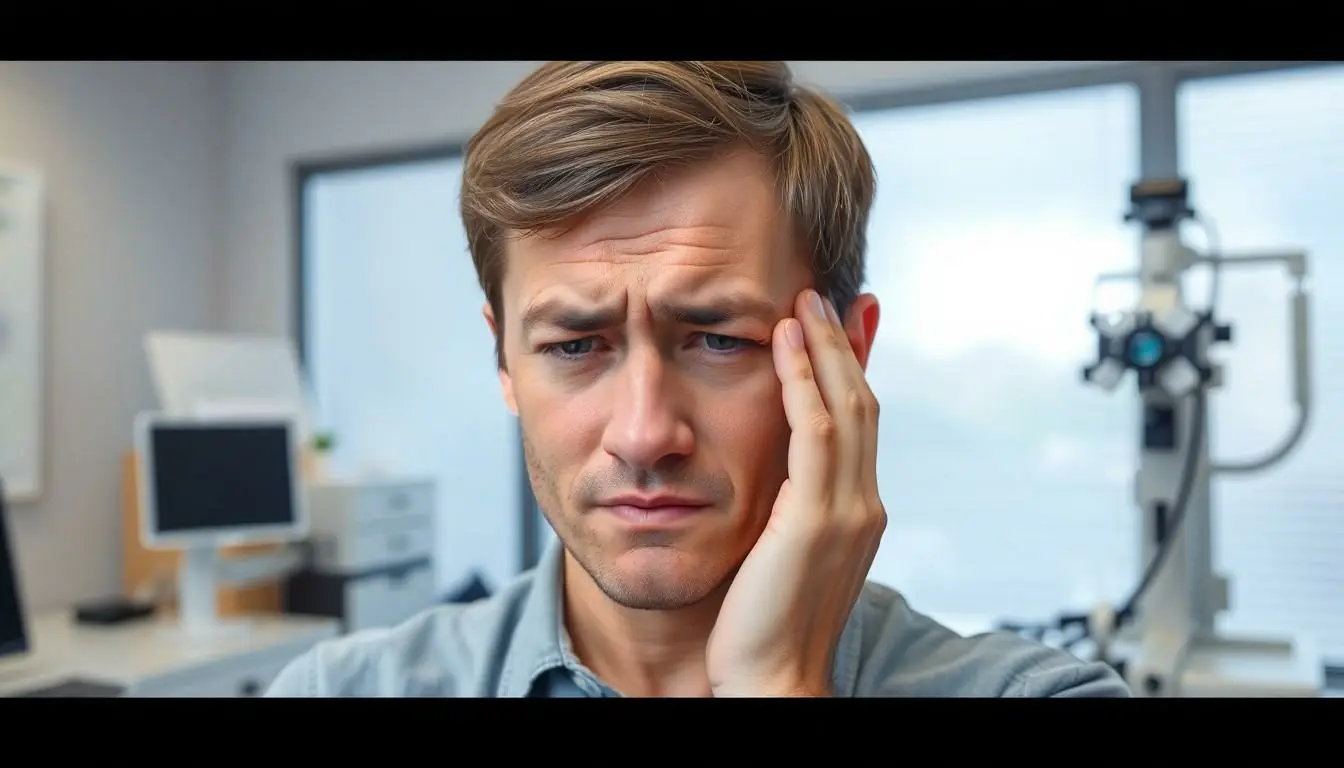Eye emergencies can strike when least expected – from that overzealous champagne cork on New Year’s Eve to an unfortunate encounter with your cat’s playful paw. While these scenarios might sound amusing they can lead to serious consequences if not handled properly.
Vision is precious and acting fast during an eye emergency can make the difference between a quick recovery and long-term complications. Whether it’s chemical exposure foreign objects or trauma knowing the right steps to take in those critical first moments can save someone’s sight. That’s why understanding basic eye emergency care isn’t just important – it’s essential for everyone from parents and teachers to workplace safety officers and outdoor enthusiasts.
Table of Contents
ToggleCommon Types of Eye Emergencies
Eye emergencies encompass various situations that require immediate medical attention to prevent vision loss or permanent damage. These emergencies fall into distinct categories based on the type of injury and needed treatment approach.
Chemical Burns and Exposures
Chemical exposure to eyes occurs from household cleaners, industrial substances or laboratory materials. Alkaline substances like bleach, drain cleaners or cement cause deeper tissue damage compared to acidic materials. The first 10-15 seconds after exposure are critical, with immediate irrigation using clean water reducing injury severity by 90%. Chemical burns affect approximately 15,500 workers annually in the U.S., making up 7% of workplace eye injuries. Symptoms include intense pain, redness, blurred vision, swelling of the eyelids or excessive tearing.
Foreign Objects in the Eye
Foreign bodies range from dust particles to metal shavings that become embedded in the eye surface. Metal workers, woodworkers or individuals exposed to airborne debris face the highest risk, with 70% of eye injuries occurring from flying particles. The cornea sustains damage in 35% of cases where objects strike the eye. Rubbing the affected eye creates additional scratches, leading to corneal abrasion. Common signs include sharp pain, light sensitivity, constant tearing or the sensation of something stuck in the eye.
Blunt Force Trauma
Blunt trauma results from direct impact to the eye or surrounding area from sports equipment, workplace accidents or falls. Impact forces create pressure waves that damage internal eye structures, causing immediate or delayed complications. Sports-related eye injuries affect 100,000 people annually in the U.S., with basketball, baseball or racquet sports accounting for 60% of cases. Symptoms include visible bruising, vision changes, seeing flashes of light or new floaters in the visual field.
Signs You Need Emergency Eye Care
Recognizing eye emergency symptoms enables quick action for sight-preserving care. Early identification of these warning signs leads to better treatment outcomes.
Vision Changes and Loss
Sudden vision changes signal potential retinal detachment or acute glaucoma. These changes include blurry vision, dark spots in the visual field, flashing lights or seeing halos around lights. Double vision indicates possible nerve damage or brain-related conditions. Complete or partial vision loss in one or both eyes demands immediate medical evaluation. Studies show 50% of retinal detachment cases result in permanent vision loss when treatment delays exceed 72 hours.
Severe Eye Pain
Intense eye pain manifests through sharp stabbing sensations, constant throbbing or burning feelings. Pressure behind the eye accompanied by redness points to acute angle-closure glaucoma. Pain that increases with eye movement suggests orbital inflammation or infection. Extreme discomfort combined with light sensitivity indicates corneal damage or inflammation. Medical data reveals 90% of acute glaucoma cases prevent vision loss with treatment within 6 hours of symptom onset.
Unusual Discharge
Eye discharge changes in color texture or volume indicate infection or injury. Green or yellow discharge suggests bacterial infection requiring antibiotic treatment. Blood-tinged discharge points to trauma or severe inflammation. Thick mucus-like secretions accompanied by pain signal corneal ulcers. Research shows bacterial eye infections spread to surrounding tissues in 85% of untreated cases within 48 hours.
First Aid for Eye Emergencies
Immediate action during an eye emergency reduces the risk of permanent damage. These first aid measures serve as critical interventions until professional medical care becomes available.
Basic Safety Guidelines
Clean hands prevent additional contamination during eye emergency care. Here’s how to approach eye emergencies safely:
- Remove contact lenses immediately if wearing them
- Keep the affected eye closed to minimize movement
- Cover both eyes with a sterile eye pad or clean cloth
- Avoid applying pressure to the injured eye
- Restrict eye movement by covering both eyes
- Position the head upright to limit fluid accumulation
- Call emergency services or seek immediate medical care
Emergency Eye Flushing
Eye flushing removes harmful substances and reduces damage from chemical exposure. Follow these steps for proper eye irrigation:
- Tilt the head sideways with the affected eye downward
- Hold eyelids open with thumb and forefinger
- Pour clean water or saline solution from the inner corner outward
- Continue flushing for 15-20 minutes minimum
- Use lukewarm water to prevent temperature shock
- Maintain gentle water pressure to avoid additional injury
- Document the type of chemical exposure for medical professionals
Avoiding Further Injury
- Leave embedded objects in place for medical removal
- Restrict eye movement to prevent scratch expansion
- Keep both eyes closed to limit muscle movement
- Avoid rubbing or touching the affected eye
- Prevent exposure to bright lights or sunlight
- Restrict phone or screen use until medical evaluation
- Keep the head elevated during transport to medical care
When to Seek Professional Help
Eye emergencies require immediate medical intervention to prevent vision loss. Recognizing where to seek treatment and identifying critical symptoms determines the outcome of eye injuries.
Emergency Room vs. Eye Doctor
The emergency room provides 24/7 treatment for severe eye trauma, chemical burns, embedded objects in the eye or acute vision loss. An ophthalmologist specializes in treating complex eye conditions but maintains limited office hours. Emergency rooms offer immediate access to CT scans, MRIs, and surgical facilities for traumatic injuries. Eye doctors excel at treating corneal issues, retinal problems or infections during regular hours. Studies show 90% of eye emergencies arriving at ERs involve trauma or chemical exposure, while ophthalmologists handle 70% of non-traumatic eye conditions.
Critical Warning Signs
Specific symptoms indicate the need for emergency care within 24 hours:
- Sudden vision changes including blind spots, flashing lights or curtain-like shadows
- Severe eye pain combined with nausea, headache or light sensitivity
- Chemical exposure to acids, alkalis or other harmful substances
- Direct trauma causing bleeding, swelling or visible deformity
- Double vision or inability to move the eye in all directions
- Eye discharge containing blood or excessive pus
- Foreign objects penetrating or embedded in the eye
Research shows 25% of patients with retinal detachment symptoms lose vision permanently when treatment delays exceed 24 hours.
Prevention and Preparedness
Eye emergencies occur unexpectedly, making proper preparation essential for minimizing damage and ensuring quick response times. Strategic prevention measures combined with readily available safety equipment create a comprehensive approach to eye protection.
Essential Eye Safety Equipment
Every home first aid kit requires specific eye safety items for emergency response. A professional eye wash station or portable eye wash bottle enables immediate chemical exposure treatment. Safety goggles with side shields protect against flying debris during home maintenance tasks. An eye shield or rigid eye patch stabilizes injured eyes during transport to medical care. Additional essential items include:
- Sterile saline solution for eye irrigation
- Clean microfiber cloths for gentle eye coverage
- Medical tape to secure eye patches
- Emergency contact numbers for local eye specialists
- Small flashlight for examining foreign objects
- Documentation cards to record incident details
Workplace Eye Protection
- Regular eyewear inspections for damage
- Proper storage stations for safety equipment
- Employee training on correct PPE usage
- Emergency eyewash station maintenance
- Clear signage indicating eye protection zones
- Replacement protocols for damaged equipment
Conclusion
Eye emergencies demand swift action and proper knowledge to prevent permanent vision damage. Recognizing warning signs preparing for emergencies and maintaining safety measures are vital steps in protecting eye health.
Whether at home work or play having the right equipment and knowing when to seek professional help can make the difference between temporary discomfort and lasting vision problems. Everyone should familiarize themselves with basic eye emergency care procedures and keep necessary supplies readily available.
Remember that vision is precious and irreplaceable. Taking preventive measures today and being prepared for potential emergencies tomorrow will help safeguard against serious eye injuries and their life-altering consequences.




